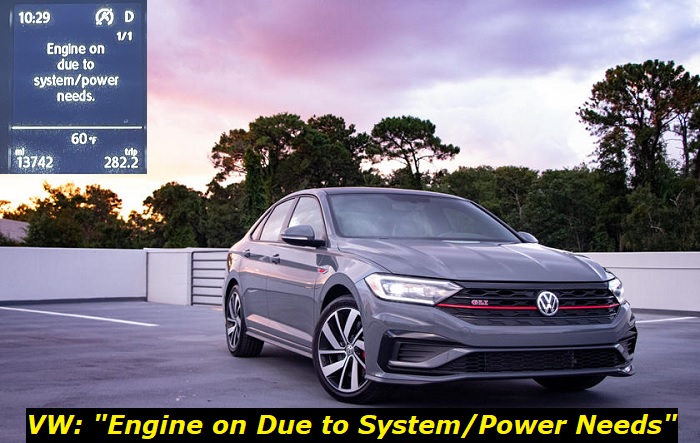Ignoring engine alerts is risky and costly. Modern car models notify you of internal issues before the engine stalls. You can save repair costs with a timely response. Some alerts are automatic responses to your actions or normal operations in your car. However, an expected signal can cause panic if you do not know its meaning.
Engine on due to system/power needs message highlights
- Common reasons:power-consuming units are working, battery is low
- How to fix:check the battery
- Possible consequences:start-stop may not work
- Priority level:Low
- Can you drive?Yes
- DIY repair:Possible
- Repair price range:$0-$200

What Does "Engine on Due to System/Power Needs" Mean?
The message may be alarming at first but you are not alone. Most drivers panic when they see an alert or warning that concerns the engine. The alert is normal and common in most cars with a start-stop system.
The alert means that the start-stop system in your Volkswagen did not shut down the engine. The technology shuts down the engine when you stop at traffic lights or engage the park gear. Some car models activate technology when you come close to a halt. The electrical components rely on the battery when the engine is off.
The start-stop system may shut the engine down or keep it running depending on the power needs. For instance, the system may fail to switch off the engine if the battery is low or the electrical parts require more power than the battery can supply.
The alternator will continue to charge the battery while the engine keeps all electronics running. The message will likely appear if the AC or heat, radio or audio, parking assistant, and heated seats are running. The alternator must keep spinning to support these electronics.
If you are keen on your driving habits, you will notice that the alert is frequent when you run multiple accessories. Installing new accessories increase power requirements. In addition, the alert frequency may increase as the battery's performance declines.
The alert may suggest a battery test or replacement if it cannot support the necessary accessories. You must also understand how the start-stop system works to avoid unnecessary panic when it sends an alert.
What Is the Start-Stop System?
The start-stop system uses information from multiple sensors in your vehicle to shut and restart the engine automatically. The system activates when you press the brakes or the clutch to stop at traffic lights. The technology switches the engine off and restarts it when the lights change.
The system detects you are ready to go when you release the clutch or step on the gas pedal. The engine will start instantly and keep running until you come to another stop. The stop-and-start process happens as often as necessary when in slow traffic.
The system is designed to save you fuel when idling in heavy traffic. The savings are significant if you live or work in a congested city. In addition, you enjoy your trips because the system automatically shuts off the engine noises when waiting in traffic.
The start-stop system helps car owners to reduce pollution by reducing carbon emissions. Most of the new car models have the system. However, some models have a button or switch that allows drivers to deactivate the system.
Some drivers find the technology disturbing and keep the AC and other electronics running to bypass the occasional engine shutdown.
Your start-stop system is active if you receive the "engine on due to system /power needs" warning. The system detects that you slowed down or stopped but did not shut the engine. Instead, it communicates that the engine is still running.
You have little to worry about regarding the alert. However, it would be best to explore why the start-stop system fails to shut the engine at a stop. Eliminate the battery and functional issues that may cause the start-stop technology to fail if you enjoy convenience.
Let us now discuss why the start-stop system keeps the engine running and the appropriate solutions.
Why Does the Start-Stop System Fail to Shut The Engine?
In most cases, the start-stop technology fails to shut the engine because of battery-related issues. The system requires a fully charged and functional battery before shutting the engine. Other operational issues and faulty parts may disable the technology as well.
1. Low Battery
A low battery charge disables the start-stop system. System failure is a protective mechanism that the battery management system activates to enable the engine to start. The engine stays on even after you stop or slow down the vehicle.
The battery requires enough power to run the AC or heat the cabin if the outside temperatures are extreme. Consequently, the start-stop system stops to ensure the fan, heater, and other electrical components work.
Some manufacturer settings allow the start-stop system to keep running even when the battery powers the AC. However, the AC does not function optimally. The system will go off if the battery runs out of charge while powering the heater or AC.
A high or low engine temperature may also cause the start-stop technology to stop. The engine must generate heat through combustion if the battery is too low to heat it. Combustion requires a high starting current.
If the engine is overheating, the airflow in slow or stop-and-go traffic is insufficient to cool it. The start-stop system deactivates to allow the radiator fan to cool the engine. The fan requires a high current that a low battery charge cannot supply.
2. Wrong Battery Technology
The start-stop system may fail if you replace your Volkswagen battery with the wrong battery. Replacing the car battery is essential. However, some conventional batteries have fewer charging cycles than your car needs.
The battery management system may not detect a new battery if the vehicle does not register it. Sometimes the battery capacity needs to be filled correctly. Hence, you must buy the correct battery for your Volkswagen model and get a qualified mechanic to install and register it.
You can also use your car and battery manual to correct any wrong entries in the battery management system. The vehicle should detect and register the battery as new to utilize its full capacity.
3. Other Independent Factors
The start-stop may fail to activate and shut down the engine because of other factors unrelated to the battery technology. The factors include:
- The passengers are not wearing their safety belts
- Active parking assistant
- The hood and car doors are not properly closed
- A broken air mass sensor
- Overloaded ventilation
- Large gradient or driving up a steep slope
- A faulty battery sensor
The issues are easy to fix. For instance, you can stop to check the doors, hood, and safety belts. Replacing the broken parts activates the start-stop technology. You may need an expert mechanic to test the sensors for malfunctions and replace them.
How to Fix the "Engine on Due to System/Power Needs" Alert
To fix the alert, consider its frequency and prevailing circumstances. For instance, if the alert appears every time you stop, with or without the several electronics running, your battery may require a replacement.
The message often disappears when you park your car and restart the engine. You do not need to fix anything if the battery and engine are in good condition.
The battery should support the electric system when the start-stop system is functional. The car battery declines in performance after several years of use. Hence, if the message is frequent, allow your mechanic to check the battery's health and replace it.
You can also replace the battery with the car's manual if it has reached the recommended service life. The battery may also run low on charge or have few charging cycles. Charge the battery fully and test its performance before replacing it.
If the message persists with a functional battery, try to reduce the number of electronics running simultaneously. You may notice that the message appears during certain seasons or weather when you must run the heater or AC.
Another recommendation is to check the start-stop system for errors or malfunctions. The system may be faulty if the error appears randomly, even when your battery can power the electrical system when the engine is off.
Visit a Volkswagen workshop for the experts to test the battery and reset the start-stop technology. Sometimes you must switch it on and off to reactivate it manually, but expert advice is recommended.
Conclusion
The start-stop system in your Volkswagen will send an alert when it does not shut the engine as expected. The alert means the battery cannot supply enough power to support all the running electronics. The wrong battery technology and low battery charge may also trigger the alert. The start-stop system keeps the engine running when the battery functions optimally because of faulty components.
If the alert is frequent, drive to the nearest car shop or mechanic for a diagnosis. Replacing the battery and any broken parts reduces the frequency of the alert. A system reset may also clear the alert. However, the alert will appear when running multiple accessories and overloading the battery.
About the authors
The CarAraC research team is composed of seasoned auto mechanics and automotive industry professionals, including individuals with advanced degrees and certifications in their field. Our team members boast prestigious credentials, reflecting their extensive knowledge and skills. These qualifications include: IMI: Institute of the Motor Industry, ASE-Certified Master Automobile Technicians; Coventry University, Graduate of MA in Automotive Journalism; Politecnico di Torino, Italy, MS Automotive Engineering; Ss. Cyril and Methodius University in Skopje, Mechanical University in Skopje; TOC Automotive College; DHA Suffa University, Department of Mechanical Engineering






Add comment